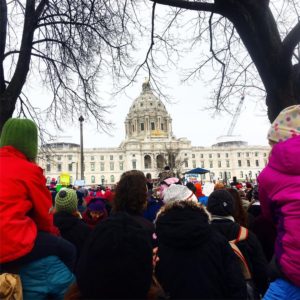
Though crowd sizes appear to be trivial, this represents several dangerous trends we need to keep our eyes on:
1. Spicer throws a bunch of (internally inconsistent) BS to obscure facts that several independent sources confirmed, from reporters and participants to the DC Metro ridership statistics. This is classic gaslighting and obfuscation. “Who are you going to believe, me or your own lying eyes?”
2. Spicer threatens to stop working with the press if they report negative stories and go around them to talk directly to “the people,” no doubt via Twitter and interviews with friendly news outlets (including those even further right than Fox). The press keeps government honest by asking uncomfortable questions, following up on stories that might have slipped from the headlines, and drawing connections between events to provide a complete narrative; it filters the government’s statements through independent inquiry and makes sure the government is backing up its assertions with facts. A representative democracy has a rich collection of “mediating institutions” between the state and the people, which help to amplify the voices of people and apply political, social, and moral pressure on the state. When the state does an end run around those mediating institutions, it starts to drift toward authoritarianism, with atomized individuals who are powerless against a unitary state. We need to keep the independent press strong if we want to maintain our democracy. (Yeah, I read too much Robert Bellah and Peter Berger as an undergrad.)
3. The press are letting themselves be trolled by this administration’s barrage of lies. NPR is reporting this story the way they would report a story about a normal administration: the administration says this, others say that, the reader should weigh the facts. But this administration is making a distributed denial of service attack on reality: they’re going to bluster so much BS that the fact checkers will be scrambling for weeks to unpack the half truths and untruths in any statement, and then bluster out even more while everyone is still coming to terms with the last blizzard of lies. This calls for a new template for this kind of story (as described in last week’s On the Media): state the facts of the matter, note that the administration’s official line conflicts with the facts, and state clearly that the administration lied. For example, “DC Metro ridership statistics and independent analysis of photographs, as well as subjective observations by reporters and participants, indicate the the Trump inauguration had significantly lower turnout than the last four inaugurations, with as little as half the turnout of Obama’s 2009 inauguration and roughly the same turnout as Bush’s in 2005. The Trump administration claimed otherwise, but did not have verifiable facts to support the claim, and lied about easily verifiable facts. The Women’s March protest drew almost the same level of participation as the first Obama inauguration, which the administration did not discuss.” We in the “fact-based community” need to take reality back, and that starts by calling a lie a lie. It’s not political bias to point out obvious lies.
4. So maybe some NPS employee got a little retweet happy and shouldn’t have shared that picture that compared Obama ’09 to Trump ’17. The NPS has a policy of not making crowd estimates. But the swift silencing of the Department of the Interior due to political posturing is chilling; much of the government (including the NPS) is made up of professionals who don’t turn over with each administration, and who have a great degree of latitude in performing their duties (within the boundaries established by the administration, of course). This degree of independence is another factor that keeps us on this side of the democratic/authoritarian divide: if everything the NPS (or other bureaus) must toe the party line, we’re one big step closer to having a political commissar assigned to each office to ensure proper ideological compliance. A scolding might have been appropriate (at most), shutting down the ability of the National Parks to market themselves and engage with the public was several steps too far.
It hasn’t dawned on the Trump administration yet that they don’t have a mandate, that they barely won the election by appealing to fear and anger in a handful of states, and that there’s a great difference between “ruling” and governing. The “consent of the governed” doesn’t end on election day, it’s a continuously negotiated state, and as of the President’s first day in office, that consent is clearly not universal, or even particularly widespread.